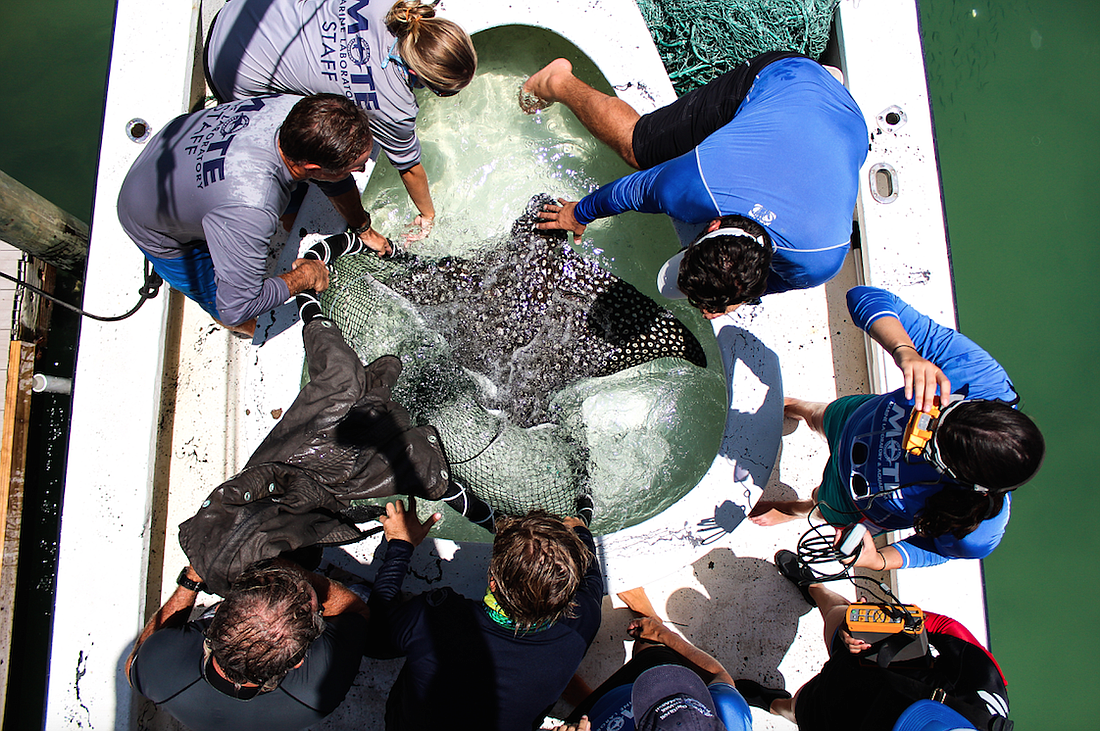- May 4, 2024
-
-
Loading

Loading

Mote Marine Laboratory and Aquarium is more than just a fun place to spend an afternoon. Behind the scenes, Mote scientists are busy conducting world-class research. Here, we highlight five research programs happening at Mote right now.
Coral Reef Restoration
In June, Mote scientists planted 200 coral during the launch of a coral project at Fort Zachary Taylor Historic State Park in Key West.
The goal is to create a site at the state park that’s accessible to the public and demonstrates current restoration strategies. In addition, the research is focused on developing propagation methods for more than 20 species of hard corals in a controlled environment.
The 21st century has brought new problems to coral reef habitats, David Vaughan, executive director of the Mote Tropical Research Laboratory, said.
One is coral bleaching caused by elevated water sea surface temperatures.
“(A goal) now is to actually use this technology as a way to be able to carry out a reef restoration since we’ve lost 25% to 40% of the world’s coral,” Vaughan said.
Goliath Grouper Research
Program manager Jim Locascio is leading a goliath grouper project aimed at integrating various acoustic technologies to understand the behavior and abundance of fish at spawning sites. The project was funded last year but began in August, when spawning season opened.
The goliath grouper is a protected species, and one goal of the study is to understand the species’ recovery.
Those working on the project are using acoustic recorders, which allow Locascio’s team to monitor fish sounds. Their sounds are indicative of courtship and spawning, so when reproductive behaviors occur, the scientists will know. However, the recorders don’t show how many fish are present; to determine that, researchers will use a fish sonar.
“The end goal is to show how effective the complement of different acoustic methods can be,” Locascio said.
Stranding Investigations Program
Mote’s Stranding Investigation Program responds to calls about sick, injured or dead marine mammals and sea turtles 24 hours a day.
When deceased animals are recovered, Mote conducts necropsies to learn more about what the animals might have faced in the wild. Scientists look at toxicology for red tide and human interaction to determine whether humans impacted the animal, program manager Gretchen Lovewell said.
Most of the animals brought to Mote are protected under the Injured Species Act or the Marine Mammal Protection Act, which afford them federal protection because they have been impacted by humans. Every animal is examined for boat strikes, entanglement and marine debris.
The program partnered with the sea turtle hatchling hospital at Mote to conduct necropsies on washbacks, or hatchlings that washed back to shore, and found that 72% of hatchlings had ingested marine debris.
Manatee Thermoregulation
During winter months, endangered Florida manatees encounter low water temperatures and cope by moving to higher temperature areas such as natural warm freshwater springs or warm water discharges. This practice, called thermoregulation, is the ability of a manatee to maintain its core body temperature independent of the surrounding temperature.
To learn how manatees maintain their body temperatures, postdoctoral student Nicola Erdsack is working to identify factors that indicate early recognition of cold stress syndrome (CSS) before life-threatening symptoms occur.
Her goal is to find out what causes manatees’ sensitivity to cold.
In addition, her research will try to identify factors influencing manatees’ susceptibility to thermal stress and generate hypotheses on the cause of CSS in manatees.
“I hope that my results will help to improve management plans and also to help manatees before they are so sick that they are going to die,” Erdsack said.
Erdsack is using infrared thermography, which allows her to measure heat radiation without having to touch a manatee.
Spotted Eagle Ray Conservation
Senior biologist Kim Bassos-Hull is doing what she likes to call “rays awareness.”
Since 2009, Bassos-Hull has studied the spotted eagle ray, a species she considers understudied. The study is focused on conservation, history, production and the population status of spotted eagle rays in the Gulf of Mexico and northwest Caribbean Sea.
Part of the study is conducting gastric lavage, the act of flushing out the stomach to examine gut contents, which helps researchers understand what the rays are eating in the area and why they’re here. But that’s not the only technique being used.
“(We) scan them, take genetic clips to understand population, take photos, look at size of animals with measurements, check sexuality maturity (and) collect some blood samples,” Bassos-Hull said.
Spotted rays tend to disappear in the winter months. To track where they migrate to, the project is using satellite and acoustic tagging.
“They obviously migrate away, and they go somewhere,” Bassos-Hull said. “Where they go is still a big mystery to us. The Keys? Rookery Bay? What is their optimum water temperature, and where are our rays from this region going?”
*Correction: This story was updated at 11:15 a.m. on Oct. 12 to reflect an error about the percentage of sea turtle hatchlings that ingested marine debris. Upon necropsies conducted by the Stranding Investigations Program in partnership with the sea turtle hatchling hospital, it was found that 72% of hatchlings had ingested marine debris.